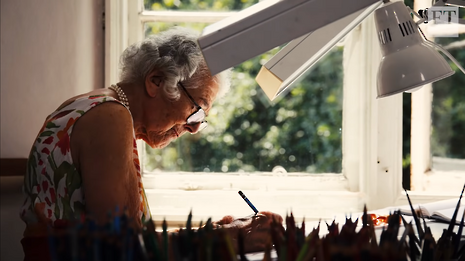Remembering Judith Kerr
Esmee Wright looks back on the work and life of the children’s author and illustrator Judith Kerr

Mog died in 2002. My own cat, Sadie, did not die until 2009 at a respectable 18 years old (which only slightly pales next to Mog’s illustrious 32 years). Somehow, the fictional death of a fictional cat stands out to me as a childhood memory in a completely different way to the losses which followed, as tragic, sorrowful and life-changing as they may have been. As my sister said last night when she heard of Judith Kerr’s death, Goodbye Mog prepared us for the inevitable.
Many were shocked that Judith Kerr would make such a bold move, having been writing and illustrating the series since the 1970s. Killing off a beloved character is controversial, no matter the medium. To kill a beloved children’s character seemed to many particularly cruel, for both Mog and her young readers. But as Kerr explained in an interview with the Guardian, “Cats do die. And so do grandparents... Because people do die, and you don’t lose them." It is this last sentence, the idea that dead does not mean gone, which meant the most to me. Mog may have slept for ever, but a little bit of her stayed awake to make sure that everything was okay afterwards.
Kerr's books remain to me the absolute apotheosis of childhood in a way the often mawkish world of children’s literature so rarely manages
And this is important because now Judith Kerr is dead. She died on the 22nd of May, at the age of 95, and although her publishers only confirmed the news today (as I write this, the day after), I have read and reread so much about her now that the exam haze has been replaced by that beautiful, surreal, childhood pleasure that comes from reading her books.
Her books were truly surreal. Her first book, The Tiger Who Came to Tea, which she wrote and illustrated herself, is a wholly bemusing story of a perfectly safe tiger coming to tea and eating everything in the house. A particular image has stayed with me, the orange tiger tucked awkwardly into the table, poised to devour the seven dainty little chocolate cupcakes proffered by the little girl in the purple, a Victoria sponge or some similar cake at his elbow. It is the vibrancy of the colours and the simplicity of the drawing that make her scenes so beautiful. And, I believe, this provides the key to her enduring popularity with children.

Antonia Fraser, an early reviewer of The Tiger Who Came to Tea, explained it thusly: “Children are so restricted by adults that the idea of the tiger emptying everything is just wonderful.” In Kerr's books there is no sensible adult telling Sophie that actually this is impossible, that a tiger is a man-eating beast and that she ought to be afraid of it. Instead her mother sets the table and her father takes them out for tea afterwards, without a single word to contradict the whole experience.
People have come up with all sorts of clever theories of a deeper meaning here, from the tiger being a symbol of the 1960s sexual revolution and the way it ransacked the normality of suburban life to it being a representation of the Nazis coming for the Jewish people. Kerr denied all such theories with a charmingly simple reiteration: it is, quite simply, about a tiger who comes to tea.
The friendly, if ravenous, tiger is a world away from the terrible reality of the Nazis, a threat Kerr really did grow up facing. Her second published book, the semi-autobiographical When Hitler Stole Pink Rabbit, recounts her childhood experiences fleeing Germany as Hitler rose to power and her family made their way across Europe to settle in Britain as refugees. The unusual title apparently nearly put publishers off, but it perfectly encapsulates the child's response to such upheaval.
Taught as a set text in German schools, the book's insight into the effect of the Nazis even on the unsuspecting and innocent is exactly what makes it such an important read. Kerr’s characteristic effervescence strikes a strange, moving balance with the horrible realities lying at the edges of her childhood consciousness.
Judith Kerr was a remarkable human being. Her books remain to me the absolute apotheosis of childhood, straddling the boundary between innocent, inspiring and educational in a way the often mawkish world of children’s literature so rarely manages. She had been thinking about the possibility of her own death since her husband and brother died, but that did not stop her from continuing to live life, and to produce more and more books. In her own words, “Remember. Remember me. But do get on with your lives.”
 News / Clare Hall spent over £500k opposing busway 24 December 2025
News / Clare Hall spent over £500k opposing busway 24 December 2025 Comment / The ‘class’ of Cambridge24 December 2025
Comment / The ‘class’ of Cambridge24 December 2025 News / Caius mourns its tree-mendous loss23 December 2025
News / Caius mourns its tree-mendous loss23 December 2025 Comment / League tables do more harm than good26 December 2025
Comment / League tables do more harm than good26 December 2025 News / Eight Cambridge researchers awarded €17m in ERC research grants27 December 2025
News / Eight Cambridge researchers awarded €17m in ERC research grants27 December 2025









